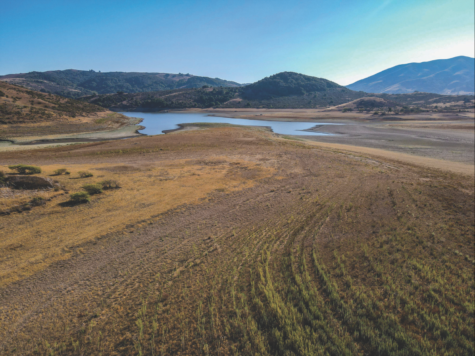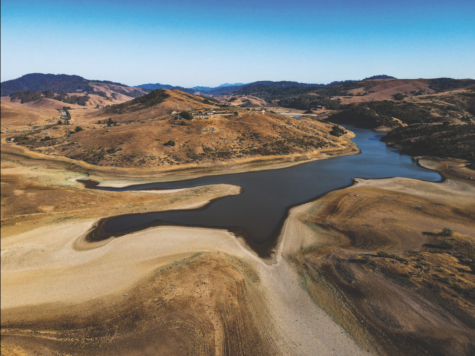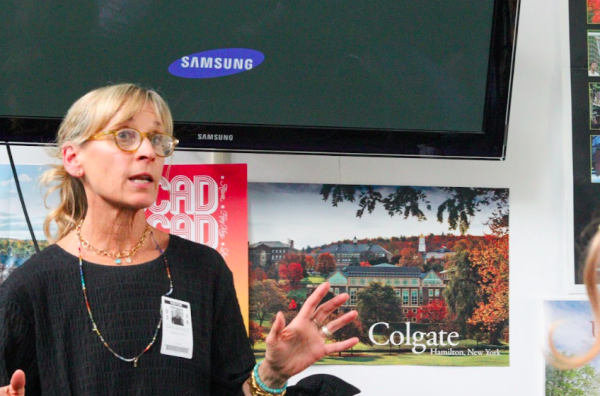County reservoirs at historic lows, local wildlife at risk
Rod Milstead
The Nicasio Reservoir, which is approximately half as full as it should be this time of year.
From 2011 through 2019, California suffered its worst drought in recorded history. Without the luxury of rainfall relief in the past year, California now suffers from low reservoir levels and likely faces two more months of hot weather until the rainy season begins. Like Marin County residents, wildlife depend on our reservoirs and now leave their territories in search of water.
The Marin Municipal Water District (MMWD) u
ses seven reservoirs for drinking water: Alpine Lake, Kent Lake, the Nicasio Reservoir, the Soulajule Reservoir, Bon Tempe Lake, Lake Lagunitas, and Phoenix Lake. These reservoirs make up 75 percent of the water used by Marin County residents in MMWD’s jurisdiction, which is composed of people from Central and Southern Marin County. Due to recent dry winters, the water levels in these reservoirs now are dangerously low.
“As of [Aug. 25], our reservoirs are 38 percent full, and [the] average for this time of year is 75 percent full. 60,000 acre feet of water is average, we have about half that,” said Jack Gibson, member of the MMWD Board of Directors since 1994.
Gibson said that because of successive dry years, the district may be on the verge of “running out” of water. To combat this possibility, MMWD will consider installing an intertie across the Richmond-San Rafael Bridge.

An intertie is a system of pipes that connects water from multiple areas, which could help aid counties whose reservoirs are not currently dependable sources of water. This intertie would help MMWD buy water from not only the East Bay, but also from the Central Valley. Without the intertie, water districts north of the San Francisco Bay could purchase water from the Central Valley, but would have no way of transporting it to their jurisdictions.
“[The intertie] opens up a whole bunch of opportunities that are simply now unavailable to us,” Gibson said.
Gibson said that the MMWD is considering partnering with a desalination plant in Antioch. This plant would turn brackish water into drinking water, which different water districts could buy. Similar to the intertie, this plan needs the construction of a pipeline across the Richmond-San Rafael Bridge for it to work for the MMWD.
Governor Gavin Newsom (D) has hinted that water rationing mandates that may be enforced as early as late Sept. 2021, possibly entailing water allotments for businesses and homes. Gibson believes that this mandate applies to large agricultural water users rather than Marin County residents.
With that being said, MMWD is part of a water-saving partnership with water districts in Sonoma, Petaluma and Santa Rosa with a goal to limit the amount of water use due to extreme drought conditions.
“We are generally trying to get people to reduce water use by 40 percent. So far, we haven’t gotten to that level, but we are working on it,” Gibson said.
Animals, also reliant on water sources, typically create their territories within easy access to the reservoirs. With water levels low, animals search for water outside their normal habitats.
“Animals are encroaching even more on our environment because the resources in their territory are being stricken, and so they go out looking for other places,” said Ellyn Weisel, the Executive Director of WildCare, a non-profit wildlife hospital in San Rafael.
Due to past dry years, WildCare now treats more animals. According to Weisel, WildCare saw an increase of 15 percent more orphaned animals over past drought years.

Weisel said that WildCare sees more baby squirrels at their facility, which will be released into the wild when they grow up. During fire season, people cut down trees to make their properties fire-safe, which often contain squirrel nests.
“Last week we had 3 dozen squirrels that were brought in that someone took down a tree in their yard because they were told to cut down the tree due to fire safety and sure enough, there was a nest in that tree,” Weisel said.
Weisel said that throughout this year’s drought, many people post messages to social networks about leaving water and food outside their homes for wildlife. Weisel said that leaving water out for wildlife can cause unintended consequences. For example, in the spring of 2021, there was a salmonella outbreak among birds who depended on people’s feeders for a reliable source of food.
“We were encouraging people during the salmonella outbreak ‘please take down your bird feeders, please clean them and wash them, and let these animals find those resources on their own,’” Weisel said.
According to the New York Times, the town of Healdsburg offers treated wastewater (also known as gray water) to water plants and lawns, which cut the amount of water used in the town by about 50 percent.
Michael Rawlins, AWHS social studies teacher, is part of an environmental-oriented academy for Juniors and Seniors called Sea-Disc (Studies of the Environment Academy Drake Integrated Studies Curricula). Sea-Disc works to inform the public about how their actions affect the environment, and what they can do to reverse issues like global warming and pollution. Rawlins believes that the MMWD could implement a system similar to the town of Healdsburg in order to use water more efficiently.
“We could…recycle a lot of our other water for a lot of those… uses that don’t require it to be drinking level grade… that could save a ton of water right there,” Rawlins said.
According to Rawlins, the biggest environmental project in Sea-Disc is a creek restoration project on a sliver of the San Anselmo Creek that runs through the AWHS campus.
“We do our creek restoration project here on campus, by removing invasive [plants] and planting native [plants]. This does help these soils hold a little bit more water and maintain that habitat, so even when it’s dry, there’s more habitat available for native species,” Rawlins said.
This year’s drought, made worse by recent successive dry winters, is considered the worst drought in California history. Districts all over California now need to find new ways to attain water, causing California residents to reevaluate how they use their scarce water resources.

Henry is a senior in high school, who loves to play tennis and enjoys spending time outdoors hiking.








